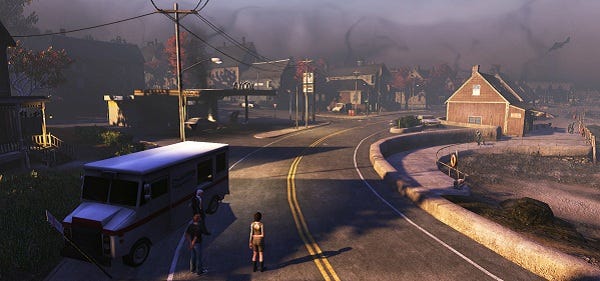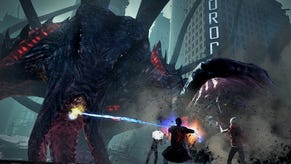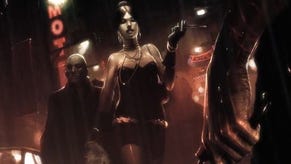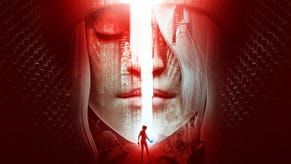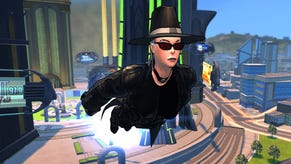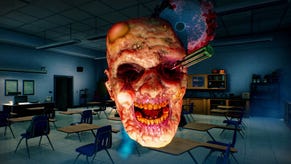Hands On: The Secret World
Cabal Rousing
I’ve had mixed feelings about The Secret World for a while now. As more details have emerged, I've found it hard to hide my excitement about the real world setting and mad mix of mythology, but I’ve been struggling to shake the suspicion that stitching them to an MMO framework could squander the potential of the scenario. The promise of classless builds and a strong narrative were intriguing, but they were only promises. That is, until last week when I spent a day playing the game and saw just how convincing it was.
The short answer is ‘very’. The longer answer follows and will be elaborated upon in an interview with some of the brains behind the game, which you'll be able to read later this week.
You may remember that John was able to watch the beginning of the game from a Templar perspective and that’s the first thing I saw as well, except I was actually in control because I'm more special. There is no choice of factions in the beta version that I played, although that’s most likely to do with secrecy rather than because those openings are incomplete. I think I can speak for all three factions when I say that they’re probably not exactly what you’d expect.
One of the things that was consistently pleasing during my time with the game was the humour in the writing. The game is so thick with references and allusions that it could have easily become a kind of Mythology Greatest Hits, but the self-awareness in the writing helps to elevate it above that. Upon joining the Templars, I was reassured that I hadn’t fallen into some “atrocious Dan brown airport paperback”. It’s a line that accepts the inevitability of the comparison but also, importantly, tells us that the characters in The Secret World know about Dan Brown. He's part of The Secret World too, because everything is.
It’s the Shaun of the Dead strategy. In Edgar Wright’s film, George Romero exists and zombies are a part of pop culture. In The Secret World, Lovecraft wrote about the mythos, so when Deep Ones emerge from the ocean there’s already a reference point for them. It’s crucial to Funcom’s world that almost everything is recognisable, but with a twist.
The game began for me as it does for every soon-to-be Templar. Asleep in bed, Eliza (almost everyone else was a man in a trenchcoat, I went for punk girl) swallows a bee and suddenly finds herself with torrents of energy streaming out of her body. The scene is reminiscent of a new X-person discovering their powers for the first time, wreaking accidental havoc on their surroundings and feeling afraid and somewhat shamed. To carry the analogy, the Templars arrive Xavier-like, and offer training and knowledge at their school for the gifted.
Finding Templar HQ was my first task in the game, which involved letting me loose in a quaint corner of London. I’m not exaggerating when I say I could have spent half an hour or more wandering the streets, reading every signpost, peeking into pubs and cafes. It’s not that there was lots to do but there certainly is a lot to see. Every building has something to mark it out, whether a name – “The Horned God” pub – or an unusual trinket on display in the window. As first impressions go, it’s a powerful one, not only because I felt that immediate desire to explore, but also because I was already looking for clues. This is a game that wants players to be detectives, sniffing out history and lore, and the small part I've seen is filled with mystery.
Before I am allowed to join my faction, there’s a bit of time travel, even though I was explicitly told by director and Longest Journey provider Ragnar Tornquist that there wouldn’t be any in the sections we played. When the rest of his team reminded him about the Tokyo Flashback sequence, which jumps back three weeks in time, he dismissed it. “Three weeks is not really travel; it’s just a small step.” With the game’s backstory covering millions of years, I think it’s safe to say there will be jumps bigger than a few weeks.
John has already talked about the flashback, which is essentially a tutorial and a glimpse of the terror that is surfacing across the globe. Like everything else, it also feels like a piece from a jigsaw puzzle. Especially the end, which placed me face to face with the cosmos.
After that rather jarring experience, I finally make my way to Templar HQ, rushing along now because I doubt anyone wants to read my hands-on experience of reading every signpost in the game. There is some talk and then a great deal of training. All the basic weapons and magic conduits in the game are placed around a room, and friendly neighbourhood Templars are on hand to describe their use and benefits. Swords, hammers, pistols, shotguns and all manner of occult practices.
This isn’t the bit where you choose a class though because, remember, there are no classes. There really aren’t. Funcom haven’t come up with another name for classes, like ‘role’ or ‘factional function’ and they don’t force you to stick with the weapons you choose during training. The whole reason for the training section is so that you can become comfortable with as many combat techniques as you wish. And that’s you becoming comfortable, not your character.
It’s the first chance to play around with some skills and those skills, or powers, are what classless characters are all about. Funcom promise over 500 in the game at launch and were keen to point out that these are 500 unique abilities, not tiered versions of basic attacks. I obviously didn’t get to experience higher level powers but I did see some in action.
Let me put it like this: my fragile life was saved from drowned and reanimated mariners by a developer controlling a man who hovered through alleyways in a crucifixion pose, surrounded by living flame that turned enemies into ashes. I think his eyes blazed white and I remember being unsure as to whether he was the embodiment of righteousness, or a refugee from the realm of a horrible, mad god.
The most supernatural ability I had was a super-speedy dash attack, which allowed me to remove a fraction of a target’s health while dodging incoming fists and fangs with uncanny speed. Hardly as impressive as emitting supernovas from my nostrils but it was enough to carve through the zombies infesting Kingsmouth. If the name sounds somewhat familiar, you’ll be reassured to know that there’s a road leading to Dunwich at the edge of town.
It’s time to talk about combat because it’s probably the area that’s hardest to understand without playing for yourself. First of all, whatever else you might have heard, The Secret World’s combat has a lot in common with other MMOs. Magic will cool down and you won’t be dashing about making headshots from behind cover. What you will be doing is targeting an enemy and then hitting it with a barrage of skills by pressing the relevant numbers on your keyboard. While this is happening, you’re free to move and dodge attacks, or manoeuvre into a better position, and if you do have guns you can fire them into a group of enemies to your heart’s content.
That won’t get you very far though. Combat is about stacking effects. I used a pistol and a sword, purely because I liked the way it looked, and attacking with the sword added counters to my character, which caused special attacks to do more damage. Some specials actually add more counters instead of consuming them, so there are sequences to learn which lends a rhythm to every fight.
With some weapons, the effects of use don’t stack on the player, they stack on the target. My guess would be that this makes them more effective against larger creatures. A shotgun, for instance, can chip away at a wendigo’s health bar, but each shell adds a mark next to that health bar. When there are plenty of markers in place, unload both barrels and the damage will be critical, possibly stunning the beastie as well.
When our group reached a particularly difficult fight at the end of a ‘dungeon’ (destroyed cargo ship), we’d only been playing the game for a few hours. Therefore, none of us fully understood the skill system but we had enough experience of combat to understand our roles in the fight. Naturally, some people were better equipped to heal and others to fight. Guess what I ended up being? The girl with the sword and the pistol?
I was the tank. There’s no armour in the game, with clothing being chosen purely for aesthetic reasons, so all skill boosts come from other forms of loot. Chakras are the main source of hit points. These invisible (on the character) charms drop fairly regularly and seven can be equipped at once, although each must go in a specific slot. So finding a chakra that provides a huge lift to attack strength may not be entirely useful if the one already equipped in its slot is your main source of defence.
I loaded up on hitpoint-boosting chakras for the fight and switched out a couple of pistol skills that targeted groups of enemies for elaborate sword-swirling techniques that created a lot of ‘hate’. That’s aggro but angrier.
So there I was, toe to toe with a giant blasphemy straight out of R’lyeh, soaking up damage so that my buddies could concentrate on keeping me alive and blasting away. By that point, I was in tune with my character and my fingers danced across the number keys, triggering skills as if I was playing a melody I’d heard a thousand times before.
Then everything went horribly, horribly wrong.
I would say that the extensive skill system means that most battles are won or lost before the fighting starts. It’s all about preparation. The ability to swap out skills and chakras means it is entirely possible to be a healer one moment and a tank the next, or to be something in between the two. Even at a low level, with few skills unlocked, I could switch between the tough absorber of all blows, and the swift and deadly assassin that I preferred when acting solo.
There is genuine flexibility and in the finished game, there will be an option to save different builds, keeping them in a sort of deck and switching between them on the fly. The sheer size of the skill wheel is quite daunting so to help players combine complimentary abilities, there’s even a built in search engine.
But back to things going horribly wrong. We had everything planned our perfectly. Everyone knew what they had to do. Then the starspawned tentacle-bastard opened a gateway to another dimension, turning our world monochrome and flayed around the edges. Long story short, the rhythm that I had perfected had to be rewritten several times during that fight and even though I was acting as a tank, I also found my dash coming in handy to find cover during those moments when dimensions kissed one another before our very eyes, causing storms of static to kill anything that didn’t quickly cower behind a rock.
There were times when I relied on what I’d learned from MMOs and there were times when my assumptions bit me on the ass. The same was true in PvP, which will come in two flavours. There are battlefields that host three-way fights between small teams and then there are the persistent warzones, with over a hundred players. We played a battlefield, El Dorado, scrapping for relics. There’s a sense of separation from what I felt was the core of the game, although I was assured that even these arenas will tie into the wider narrative. It was enjoyably hectic and, most important of all, the journalists triumphed. We did have the level designers on our team but what of it?
Forget the fighting though, because my favourite part of the game was my experience with investigation missions. They are accepted from NPCs, just like the more traditional quests, but they are all about using the old noggin. It’s here that the world really takes centre stage, with clues hidden in the details of a building or a street sign, or in the names on a map. A quick word on maps – they are all relevant to the area, so London has a conventional street map while one Area That I Cannot Name has inky trails tattooed on human flesh.
The first investigation mission I undertook actually required the use of Google, not in the game but on the actual computer I was playing on. Real world knowledge that I sorely lacked was required. It’s at times like that, standing in front of a portrait and trying to figure out which historical painter’s style it's mimicking, that I felt myself most absorbed. Even though I was tabbing out of the game to search the internet, I was in the game more than at any other time, because its whole philosophy is to blur the lines between the real world and The Secret World. They are one and the same and at that moment, they really were.
It's not just the investigation missions that form short stories though. All of the quests, even those that mostly involve biffing zombies, have enough dialogue and character to form interesting narratives of their own. Killing zombies isn’t just a way to clear an area, it’s a way to learn about how their biology works, with a full report sent back to Templar HQ. There’s a purpose to everything.
Even taking a lunch break from the game proved enlightening - "rather than quitting, you might want to just go to the church. The zombies can't follow you in there", spaketh one of the devs. Sure enough, the angry undead disintegrated at the threshold and my budding Templar rested there in peace while I scoffed down a baguette. They can't walk on holy ground, I thought to myself, but it was only later that I noticed the Illuminati symbols hidden in the stained glass. Questions, questions, questions.
I can’t speak for the larger narrative except to say that I’m excited about discovering it for myself. I never doubted the passion behind the project, or the talent, but in the past I’ve questioned whether an MMO is really the type of lens I want to experience this world through. I enjoyed my time playing and the emphasis on crafting a story is obvious even from the two incomplete areas that I experienced. Kingsmouth feels like an overrun town, with most of the survivors barricaded in the police station, helicopters flying overhead and sirens screaming through the fog. It's easy to see the man behind the curtain, with loot-drops and quest-givers safely holed up in basements waiting for the player, but it's a beautiful curtain that's billowing rather atmospherically.
It’s a huge challenge, building an MMO that has so many narrative threads running through it, but I think I understand a little better how it will work. There will be large set pieces, sure, but the brilliance of The Secret World may be in the way it asks its players to piece every detail of the promised 150-200 hours of content together. The world doesn’t just contain one story, or even hundreds, the world is the story and it will continue in every conversation that attempts to understand how the world works, and what ties all these myths together. It's not just about multiple players fighting together; it's about them talking together, particularly during those investigations.
If you have unanswered questions, fear not. Much more about the lore, design decisions and Funcom's future plans coming very soon.
